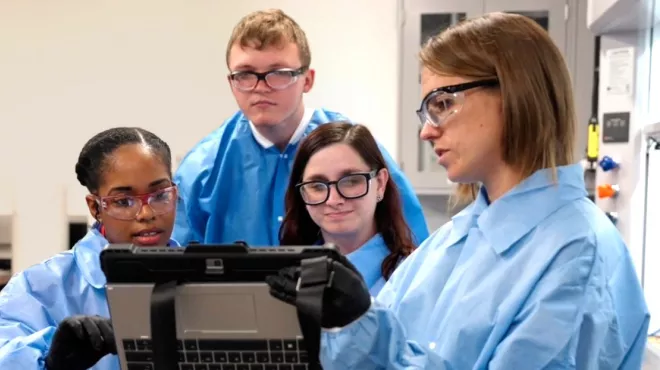The last few decades have brought remarkable advances in how blood cancers and serious blood disorders are treated. New types of medicines have changed some diseases, like chronic myeloid leukemia (CML), from acute – and often fatal – diagnoses into chronic conditions patients can live with for many years.1 Other areas of hematology research have brought new treatment options for people with rare and nonmalignant (benign) blood disorders.2-4
And even more critical research is underway to support the millions of people globally living with blood cancers or disorders.5 Novartis has been at the forefront of this field, developing medicines that have helped transform treatment paradigms and helped patients with blood diseases and disorders live their best lives. And we don’t plan on slowing down.
A history of innovation in hematology care
In the mid-1970s, the estimated five-year survival rate for patients with CML was only 22%.6 Today, the five-year survival rate is estimated above 70%.6 This shift has been due in part to the introduction of targeted therapies, like tyrosine kinase inhibitors (TKIs), which Novartis and its partners worked to advance. The first one, approved by the FDA in 2001, made CML a chronic, rather than life-limiting, condition.7 A few years later came a selective TKI that introduced the possibility of treatment-free remission for CML8 – and more recently, a CML medicine with a new mechanism of action expanded care for patients with resistances and/or intolerances to currently available TKI therapies.9
Meeting with hematologists in the field or at conferences, I feel their sense of urgency to find the next best medicine for their patients and their dedication to changing patients’ lives. It fuels our commitment to this area and makes me excited for the promise of our ongoing innovation to further build our legacy in advancing care for blood cancers and hematologic diseases. And I have absolutely no doubt that we can deliver even more transformative medicines for patients in the near future.
Victor Bultó, President of Innovative Medicines US
Another innovation that changed the landscape of blood cancer care was the development of CAR-T therapy, a groundbreaking form of therapy – gene therapy – that enables the immune system to fight cancer cells more effectively. The first CAR-T therapy was developed by Novartis and approved by the FDA in 2017 for pediatric and young adult patients (up to 25 years in age) with refractory Acute Lymphoblastic Leukemia (ALL).10 And to expand the reach of CAR-T, we developed T-Charge™, a next-generation CAR-T manufacturing platform that has the potential to be the foundation for a number of investigational pipeline CAR-T cell therapies.11
Other advances in recent years have spanned Acute Myeloid Leukemia (AML),12-14 myeloproliferative neoplasms (MPN),1 graft-versus-host disease (GvHD),1,15 immune thrombocytopenia (ITP),1,2 and chronic iron overload.16,17 We’ve been heartened to have been part of each of these developments and are committed to continuing our innovation in the lab so that we can have even more meaningful impact on patients’ lives in the future.
A pipeline of hope
Significant developments in hematology have meant patients’ expectations for treatment have fundamentally shifted. We're no longer just talking about extending lives, but about helping people with blood cancers and disorders live symptom-free and even potentially treatment-free, as part of our commitment to the next generation of innovation.
Jeff Legos, Executive Vice President, Global Head of Oncology and Hematology Development at Novartis
Across the globe, Novartis is conducting clinical trials with the aim of turning data into real-world treatment options for patients. One way to do this is to advance care where existing treatments may not fully control symptoms or may be inconvenient or cumbersome for patients.18,19 Paroxysmal nocturnal hemoglobinuria (PNH) is a rare, chronic, and serious blood disorder, in which some red blood cells more susceptible to being destroyed by the immune system’s complement system.20 In PNH, red blood cells break apart (hemolysis), leading to blot clots (thrombosis) and impaired bone marrow function, as well as anemia and fatigue.20 Although PNH treatments exist, they require infusions at healthcare centers, and may leave some patients still anemic, in need of blood transfusions, and fatigued.18,19
We believed a more convenient and more effective option was possible. A molecule discovered at Novartis is being studied for a range of complement-system-mediated diseases, including PNH.21,22 Because it is an oral investigational treatment that may significantly reduce the destruction of red blood cells – and the need for blood transfusions – in PNH, it has the potential to change how the disease is treated and improve patients’ everyday lives.21,22
Immune thrombocytopenia is another rare blood disorder – affecting platelet cells – that can leave patients with symptoms that affect their quality of life, including significant fatigue.23 Having been a pioneer in ITP treatment years ago and understanding there were still opportunities to advance care, we knew we could do more. So we’ve been advancing a molecule engineered to have a unique structure, known as a B-cell-depleting antibody, that may provide a more effective option for patients with ITP.24
And we’ve got a number of other promising medicines in the pipeline, spanning CML, AML, myelodysplastic syndrome, atypical hemolytic uremic syndrome and warm autoimmune hemolytic anemia.25 In one case, we’re investigating our approved third-line CML treatment across multiple treatment lines, to bring patients an effective option earlier on in care.9 Whether life-threatening or benign, we believe that uncovering the mechanisms that drive disease and listening to what patients most need from their treatments can drive fundamental advances in care.



